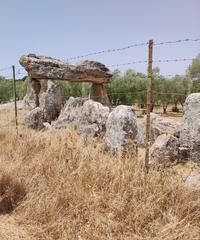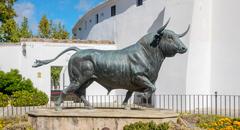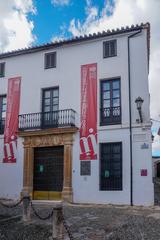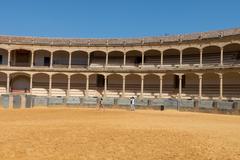Convento de Santo Domingo Ronda, Spain: Visiting Hours, Tickets, and Historical Sites Guide
Date: 14/06/2025
Introduction
The Convento de Santo Domingo in Ronda stands as one of Andalusia’s most significant historical monuments, blending centuries of religious tradition, striking architecture, and vibrant contemporary culture. Founded in the aftermath of the Christian Reconquest of Ronda in 1485, this former Dominican monastery has evolved from a center of faith and power into a dynamic cultural venue. Today, it welcomes visitors to discover its unique blend of Gothic, Mudéjar, Renaissance, and Baroque features, as well as to experience world-class art exhibitions and music festivals. This comprehensive guide provides everything you need to know about visiting the Convento de Santo Domingo, including its history, architecture, visiting hours, ticket information, accessibility, and tips for making the most of your trip (Oway Tours; Casa Candela Ronda; Ronda.ws; VoyageTips; Turismo de Ronda; Ronda Semanal).
Table of Contents
- Introduction
- Historical Overview and Foundations
- Architectural Evolution and Artistic Highlights
- Historical Roles and Transformations
- Restoration and Contemporary Use
- Visiting Information: Hours, Tickets, Accessibility
- Travel Tips and Nearby Attractions
- Cultural Events and Exhibitions
- Frequently Asked Questions (FAQ)
- Conclusion and Final Tips
- References
Historical Overview and Foundations
Founded shortly after the Christian reconquest of Ronda by Ferdinand and Isabella in 1485, the Convento de Santo Domingo was established to consolidate Christian rule and spiritual life in the city. The site, previously of strategic military importance, was granted to the Dominican Order—renowned for their educational and ecclesiastical influence—to foster religious and social transformation (Casa Candela Ronda). Its construction over earlier Arabic foundations symbolizes Ronda’s transition from Moorish to Christian rule, with the convent quickly becoming a central institution in the emerging Christian cityscape.
Architectural Evolution and Artistic Highlights
Styles and Features
The convent’s architecture is a tapestry of styles reflecting centuries of change:
- Gothic-Mudéjar: The earliest sections of the convent, particularly the church, display high ribbed vaults, pointed arches, and the remarkable polychrome Mudéjar wooden ceiling—a rare survival of Islamic-influenced carpentry in post-Reconquista Spain (Oway Tours).
- Renaissance: The cloister, with its harmonious arcaded galleries and classical columns, exemplifies Renaissance design principles of order and proportion.
- Baroque and Mannerist Elements: Later renovations introduced decorative flourishes and structural updates, particularly in the cloister and façade.
Artistic Details
- The main nave’s wooden beams are adorned with Dominican escutcheons, palm motifs, and crowns, symbolizing martyrdom and victory.
- The cloister, built in the late 16th century, offers a tranquil courtyard that once served as a meditative space for friars.
- The sacristy and chapter house feature intricately carved Mudéjar artesonado ceilings, showcasing the enduring legacy of Islamic art in Andalusian Christian architecture (Casa Candela Ronda).
Historical Roles and Transformations
Originally a Dominican monastery dedicated to San Pedro Mártir, the convent was integral to Ronda’s religious and civic life. It served as the Court of the Inquisition, a role commemorated in the coats of arms on its façade (Oway Tours). The mausoleum of the Moctezuma y Rojas family, descendants of Aztec emperor Moctezuma II, further highlights its role as a site of memory (Ronda.ws).
With the secularization of religious properties in the 19th century, parts of the convent were demolished to make way for a new city market. In the 20th century, it was repurposed as a furniture factory and later, following extensive restoration, transformed into Ronda’s Palacio de Congresos y Exposiciones—a civic and cultural center (Casa Candela Ronda).
Restoration and Contemporary Use
After periods of neglect and fire damage, the convent was purchased and restored by Ronda’s City Council in the 1980s. The emphasis was on preserving the church and cloister while adapting the space for modern cultural and social events (Oway Tours). Today, the Convento de Santo Domingo operates as the Ronda Congress Palace, hosting art exhibitions, conferences, and music festivals. Its adaptive reuse is a model for heritage conservation in Spain.
Visiting Information: Hours, Tickets, Accessibility
Location
- Address: Calle Armiñán 1, Ronda, near Puente Nuevo and the Tajo gorge
Opening Hours
- Standard Hours: Tuesday to Sunday, 10:00 AM – 6:00 PM
- Closed: Mondays and public holidays
- Note: Hours may vary during special events—always check the Turismo de Ronda website for current information.
Ticket Prices
- General Admission: €5 (includes exhibitions)
- Discounted: €3 for seniors/students; free for children under 12 and Ronda residents
- Tickets: Available on-site or online via the official website
Guided Tours
- Times: Daily at 11:00 AM and 4:00 PM
- Languages: Spanish and English (others by prior arrangement)
- Booking: Recommended in advance
Accessibility
- Wheelchair Access: The main church is accessible; some cloister areas may require assistance due to historic stairs.
- Facilities: Accessible restrooms, ramps where feasible
Travel Tips and Nearby Attractions
- Best Time to Visit: Early mornings or late afternoons for a quieter experience and better photography light
- Getting There: Located in Ronda’s historic center, a short walk from Puente Nuevo. Public parking and taxis are available nearby.
- Combine Your Visit: Explore nearby sites such as the Arab Baths, Plaza de Toros, and Mondragón Palace (Tricks and Trips; VoyageTips).
- Photography: Allowed in most areas (flash and tripods may be restricted during exhibitions)
- Amenities: Restrooms, gift shop, nearby cafés
Cultural Events and Exhibitions
The convent is a vibrant cultural hub:
- Art Exhibitions: Hosting major shows like “Picasso, la tauromaquia” (June 2024–January 2025), featuring works by Picasso and other 20th-century artists (Ronda Semanal; Official Ronda City Website)
- Music Festivals: Annual Ronda International Guitar Festival (June 3–7, 2025), bringing together world-renowned classical and flamenco guitarists (Ronda Guitar Music)
- Community Events: Conferences, lectures, and civic gatherings
Frequently Asked Questions (FAQ)
Q: What are the Convento de Santo Domingo visiting hours?
A: Typically Tuesday to Sunday, 10:00 AM – 6:00 PM; check for variations during events.
Q: How much does admission cost?
A: €5 for general admission; discounts and free entry for certain groups apply.
Q: Are guided tours available?
A: Yes, at 11:00 AM and 4:00 PM daily, in Spanish and English.
Q: Is the convent accessible for visitors with disabilities?
A: Main areas are accessible; please inquire for detailed information.
Q: Can I take photographs inside?
A: Photography is generally allowed except where restricted in special exhibitions.
Q: What other attractions are nearby?
A: Puente Nuevo, Baños Árabes, Plaza de Toros, and Mondragón Palace are all within walking distance.
Conclusion and Final Tips
The Convento de Santo Domingo is a cornerstone of Ronda’s heritage—its Gothic, Mudéjar, and Renaissance architecture, layered with history and brought to life by contemporary art and music, offers an unforgettable experience for every visitor. Plan your visit around exhibitions or festivals for a deeper insight into Ronda’s cultural life. For up-to-date schedules, ticketing, and accessibility information, always check official resources (Turismo de Ronda; Oway Tours). Enhance your experience with the Audiala app, which provides audio guides and event listings. Follow Ronda’s cultural channels on social media to stay informed about upcoming events.
References
- Oway Tours
- Official Ronda City Website
- Casa Candela Ronda
- Turismo de Ronda
- Ronda.ws
- VoyageTips
- Ronda Semanal
- Ronda Guitar Music
- Tricks and Trips
Images and media to be included:
- High-quality photographs: “Convento de Santo Domingo facade in Ronda”, “Renaissance cloister of Convento de Santo Domingo”, “Mudéjar artesonado ceiling at Convento de Santo Domingo”, “Picasso exhibition inside Convento de Santo Domingo”
- Interactive map showing convent’s location
- Links to virtual tours (if available)
Internal links to related articles on Ronda’s historic sites and art exhibitions will be provided to enhance the user experience and SEO.
Download the Audiala app for audio guides, event updates, and more insider tips for your Ronda adventure!



